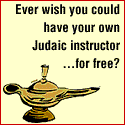
Jonathan Tobin
http://www.jewishworldreview.com -- ENGLISH HISTORIAN PAUL JOHNSON said that if you wanted to understand the Jews, you had to go to Hebron, because that is where it all began. He began his 1987 book, "A History of the Jews," by writing, "The Jews are the most tenacious people in history. Hebron is there to prove it."
That quote came readily to mind last week during a brief trip to Israel, when I visited the ancient city in the Judean hills 20 miles south of Jerusalem.
There are some places in the world where time seems to stand still as the antique beauty of a site bewitches both the serious and casual visitor. For all of its interesting antiquity, Hebron is not such a place.
Rather, time there is fluid. Like the experience of the time traveler in Kurt Vonnegut's novel "Slaughterhouse Five," time in Hebron seems to be spastic - continually and involuntarily jerking back and forth between the past, the present and the future.
Is the date 1999? Maybe. But wherever the visitor looks, there are reminders of other dates: 1929, 1967, 1980, 1994, last year, last month. Most are commemorations of tragedies. In this one small place, millennia of strife and bloodletting between the children of Abraham seem to come together. Hebron is a microcosm of Jewish sorrow and struggle.
For the some 550 Jews who currently live here, surrounded by an Arab population estimated at approximately 100,000 Arabs (several thousand Jews also live close by in the Jewish suburb of Kiryat Arba), scenarios about the future of the peace process are meaningless.
WHERE HISTORY RULES
Everywhere there are signs of the 1929 massacre in which Arab mobs
destroyed the centuries-old Jewish community and murdered 67 Jews. To
understand why Jews insist on living in the tinderbox that is Hebron today,
one must comprehend that piece of history.
They have dedicated their lives to righting that historic injustice. According to the Bible, Hebron is where Abraham purchased a grave site for his wife, Sarah. In turn, his sons, Isaac and Ishmael - the fathers of the Jews and the Arabs, respectively - buried him there. Tradition has it that Isaac and his wife, Rebecca, as well their son, Jacob, and his wife, Leah, are also laid to rest at Machpelah - the Tomb of the Patriarchs.
 Later on, the Tanach noted the city's status as King David's first capital
(before Jerusalem). Even after the destruction of Jerusalem and the exile
of the Jews, Jewish life here persisted until 1929 under the sovereignty of
a variety of rulers, including the Arabs, Frankish Crusaders, Egyptian
Mamluks, Turkish Ottomans and British.
Later on, the Tanach noted the city's status as King David's first capital
(before Jerusalem). Even after the destruction of Jerusalem and the exile
of the Jews, Jewish life here persisted until 1929 under the sovereignty of
a variety of rulers, including the Arabs, Frankish Crusaders, Egyptian
Mamluks, Turkish Ottomans and British.
The building that houses Machpelah was built by Herod 2,000 years ago, but from 1266 C.E. until 1967, Jews were forbidden to enter the shrine, which was transformed into a mosque. They were permitted only to ascend to the seventh step of the eastern wall of Machpelah - a rule that symbolized the power of the land's Arab rulers and the powerlessness of the Jews.
Israel's victory in the 1967 Six-Day War ended that ignoble tradition and Jewish worship was restored to Machpelah alongside that of the Muslims.
Against the will of a number of Israeli governments, Jews returned to the city to reclaim former Jewish properties and put down new roots. The historic Avraham Avinu synagogue was rebuilt and filled with Torahs that were saved from the mob in 1929.
But on Purim eve in 1994, a Kiryat Arba doctor named Baruch Goldstein opened fire at a group of Arab worshippers inside Machpelah, murdering more than 30 in cold blood. That act of senseless violence (often rationalized by Hebron's Jews as a reaction to Arab terror and threats of violence) crystallized the image of Hebron's Jewish residents as extremists who are bent on subverting any hope of peace.
A COMPLICATED ARRANGEMENT
The stubborn refusal of the Jews of Hebron to leave their enclaves (in
fact, they continue to build homes and a waiting list exists to get into
the city) amid an otherwise Arab-populated city complicates any plan for
separating Israeli settlements from areas that will constitute the future
Palestinian state.
Since January 1997, when former Prime Minister Benjamin Netanyahu signed the Hebron Pact with the Palestinian Authority, the city has been divided into two sectors. One is completely under the control of the Palestinian Authority, or "Arafatland," as the settlers call it. The other - including the Tomb of the Patriarchs and the Jewish enclaves - remains under Israeli rule.
Walking about Hebron and visiting the homes and community buildings of the Jews there - which are separated by mere yards from the Arab areas - it was easy to see the security problems of the status quo there.
Although only a couple of hours away from Hebron by car, the cafes and
nighclubs of secular Tel Aviv feel a lot farther away. Yet, the
indifference of many, if not most Israelis, to the fate of Hebron, and the
parallel desire of their Arab neighbors to rid themselves of this Jewish
presence, are irrelevant to the Jews of Hebron.
To walk among the Jews of Hebron is to experience a courage that is, at one and the same time, inspiring and a little scary. How can anyone live, I wonder - let alone raise families - under such pressure and constant danger? When asked about whether the Jewish kids living in Hebron were given counseling about dealing with the stress of living under constant siege, I was told that such help is there if anyone requests it. The reply implied that since their children understand why they are there, there isn't a need for such services except after major tragedies.
Every spot within the enclaves that make up the Jewish community there bears witness to some Jewish sorrow, whether ancient or recent. A room in a "caravan" or mobile home that faces out on the city has been transformed into a small synagogue, because it was there that a rabbi was stabbed to death in his home by an Arab terrorist last year. An intersection is named for the six yeshiva students who were gunned down in an ambush in 1980.
Greater security measures, such as high walls to surround the Jewish enclaves or bullet-proof sealed windows, are rejected by the settlers because, they say, they refuse to live in a ghetto. More than mere bravado, that decision reflects a faith that transcends politics.
A BRIS MILAH AND TERROR ON THE SAME DAY
After a tour of the city, I went to the Machpelah, which has been divided
between Jews and Arabs since 1994. It remains a point of contention, as
Hebron's Arab mayor recently said that Jews would not be allowed to pray
there if the site comes under the jurisdiction of a Palestinian state.
But inside, as if in vivid counterpoint to the memorials for the dead that are so prevalent in the city, I witnessed a family bringing a baby into the covenant of Abraham by circumcising him as the patriarch did to his son Isaac. As I took the last daylight bus out of the city back to Jerusalem, the thought of the symbolism of that brit milah left me with a feeling of hope.
But upon arriving in Jerusalem, I heard the news that only an hour after I had left Hebron, a terrorist ambush set up along the same street I had travelled had wounded two Israelis. The attackers had only to dash a few yards back into P.A. territory to evade capture.
What does the future hold for Hebron and its Jews? It is almost impossible to imagine any compromise that would satisfy either Jews or Arabs. Despite the complicating factor they represent for the peace process, the idea of removing the Jews from this historic place is repulsive.
If Jews have no right to live in Hebron, the settlers ask, then what right
do Jews have to live anywhere in the land of Israel? Whether you view them
as dangerous extremists or as heroes, that is a question that is difficult
to
JWR contributor Jonathan S. Tobin is executive editor of the Philadelphia Jewish Exponent. Let him know what you think by clicking here.


